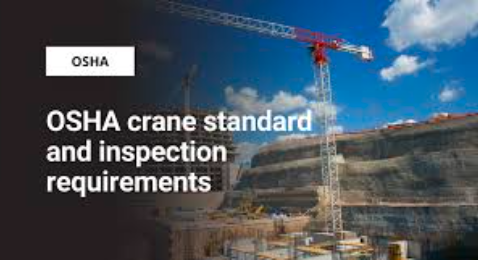Standards for Crane Safety Can Be Found in OSHA Regulations: Here’s What You Need to Know

The standards for crane safety can be found in OSHA regulations, which provide comprehensive guidelines to ensure safe crane operations in various industries. Understanding these standards is essential for employers, operators, and safety personnel to prevent accidents and maintain compliance with federal safety requirements. In this article, we’ll break down the key OSHA rules and explain what you need to know to keep crane operations both safe and efficient.
Why Crane Safety Is Non-Negotiable
Cranes move massive loads, and accidents happen suddenly. That’s why OSHA regulations require strict training, proper setup, and thorough inspections before any lift.
Many accidents happen because basic safety steps are skipped:
- Setting up on soft or unstable ground
- Ignoring load charts
- Missing worn wires or damaged parts
- Miscommunication, like misheard hand signals or failing radios
Most crane accidents happen because of human error, so ignoring safety is extremely risky. Following clear procedures, providing proper training, and staying alert at all times are essential to protect workers to prevent accidents.
Where Crane Safety Standards Are Found in OSHA Regulations
Crane safety standards are primarily located in two key OSHA sections:
- 29 CFR 1926 Subpart CC – Cranes and Derricks in Construction
- Applies to cranes used on construction sites, including tower, mobile, crawler, and floating cranes.
- Covers operator certification, inspections, lift planning, signaling, power-line safety, and safe operation practices.
- 29 CFR 1910 Subpart N – Cranes and Hoists for General Industry
- Applies to cranes used in factories, warehouses, and other general industry settings, including overhead and gantry cranes.
- Covers maintenance, inspections, clearances, and safe operation procedures.
These OSHA sections, together with ASME B30 standards, form the foundation for safe crane operation across different crane types and work environments.
Who’s Responsible and What’s Required: OSHA-Compliant Crane Operation and Maintenance
OSHA places the responsibility for safe crane operations primarily on employers. Compliance involves ensuring qualified personnel, proper inspections, maintenance, and emergency preparedness.
- Operator Certification & Licensing
Employers are responsible for ensuring all crane operators are properly trained, certified, or licensed before operating covered cranes. They must evaluate operators on the specific cranes they will use and keep records on-site. Some small cranes or certain types (like sidebooms and derricks) are exempt from formal certification, but operators still require training. Legal responsibility for compliance rests with the employer.
- Qualified Signal Persons, Riggers, and Supervisors
Signal persons need to know standard hand and voice signals and understand the crane’s limits. Riggers must safely attach and balance loads, especially in fall zones or when using specialized rigging. Supervisors must verify that everyone’s credentials are current and stop work if qualifications expire. All qualifications should be documented and kept on-site for verification.
- Inspection and Maintenance
- Daily inspections: Operators check the crane’s controls, ropes, hooks, safety devices, and the ground conditions before starting work.
- Monthly inspections: A more detailed check that must be documented and kept on-site for at least three months.
- Annual inspections: Conducted by a qualified person, and the records are kept for at least one year.
- Maintenance logs: It’s recommended to keep a log for the entire life of the crane, going beyond OSHA minimums, to ensure safety and track repairs.
- Emergency Preparedness and Daily Compliance
Crews should be trained on emergency procedures, such as responding to crane tip-overs, power-line contact, or rescuing workers at height. Use digital checklists and maintenance management systems to keep track of inspections and repairs. Assign clear roles and provide resources for fast, effective emergency response.
Employers are responsible for ensuring qualified personnel, proper inspections, documentation, and emergency readiness. Following OSHA regulations and best practices keeps crane operations safe, protects workers, and prevents accidents and citations.
OSHA Compliance and Enforcement
OSHA ensures crane safety through inspections, enforcement, and recordkeeping requirements.
- OSHA Inspection Process
OSHA inspectors may visit worksites to check crane operations, procedures, and records.
- They focus on operator qualifications, equipment condition, lift plans, and compliance with safety rules.
- Inspections can be random or triggered by complaints, accidents, or reports of unsafe conditions.
The goal is to ensure cranes are operated safely and workers are protected.
- Common Violations and Penalties
Frequent OSHA violations on crane sites include:
- Operating cranes without certified operators.
- Skipping inspections or failing to document them properly.
- Overloading cranes or using improper rigging.
- Lacking adequate safety measures near power lines.
- Not keeping proper records of training, inspections, or maintenance.
Penalties:
- Citations and fines.
- Stop-work orders in severe cases.
The severity and frequency of violations determine the level of enforcement.
- Required Recordkeeping
Employers must keep clear records of:
- Certifications for operators, signal persons, and riggers.
- Inspections are done daily, monthly, and annually.
- Maintenance and repair logs for all crane equipment.
- Lift plans and hazard assessments.
These records ensure compliance with OSHA rules and help keep crane operations safe.
Compliance with OSHA crane regulations requires proper training, inspections, maintenance, and recordkeeping. Violations can lead to serious penalties, making consistent adherence essential for worker safety and legal compliance.
Best Practices for Employers and Operators
To ensure crane operations are safe and OSHA-compliant, employers and operators should follow these key practices:
- Pre-Lift Planning
Pre-lift planning is all about preparing for safe crane operations:
- Check the weather: Look at both short-term (hours or days ahead) and long-term (weeks ahead) forecasts to spot hazards like strong winds or storms.
- Pick calm times: Plan crane lifts for calm weather whenever possible to minimize risks.
- Have backup plans: Be ready to stop the lift, secure the load, or move equipment if conditions change suddenly.
Careful planning like this helps protect the crew, prevent accidents, and keep crane operations safe.
- Real-Time Wind Monitoring
Real-time wind monitoring means keeping track of wind conditions while the crane is operating:
- Install anemometers at the same height as the crane to accurately measure wind conditions that affect both the crane and the load.
- Wireless devices can send live readings and alerts to the crew, so everyone can respond immediately if wind speeds become unsafe.
This helps prevent accidents, keep lifts stable, and protect both the crane and personnel.
- Crew Communication
Clear communication is essential for safe crane operations:
- Stay in constant contact: Make sure all team members can hear and understand each other during lifts.
- Follow wind alert protocols: Everyone should know how to respond if wind speeds rise or conditions become unsafe.
- Use real-time alerts: Devices that give live updates so the crew can respond quickly and make safe decisions.
Good communication ensures everyone knows what’s happening, can react promptly, and stays safe on site.
- Operator Decision Authority
Crane operators must have the authority to stop or pause a lift right away if conditions seem unsafe. This lets them respond quickly to sudden wind gusts, equipment problems, or other risks, helping keep both the crew and the crane safe.
Careful planning, real-time monitoring, clear communication, and empowered operators keep crane operations safe.




